Jiachen Zhu
A Survey of Process Reward Models: From Outcome Signals to Process Supervisions for Large Language Models
Oct 09, 2025Abstract:Although Large Language Models (LLMs) exhibit advanced reasoning ability, conventional alignment remains largely dominated by outcome reward models (ORMs) that judge only final answers. Process Reward Models(PRMs) address this gap by evaluating and guiding reasoning at the step or trajectory level. This survey provides a systematic overview of PRMs through the full loop: how to generate process data, build PRMs, and use PRMs for test-time scaling and reinforcement learning. We summarize applications across math, code, text, multimodal reasoning, robotics, and agents, and review emerging benchmarks. Our goal is to clarify design spaces, reveal open challenges, and guide future research toward fine-grained, robust reasoning alignment.
Superplatforms Have to Attack AI Agents
May 23, 2025Abstract:Over the past decades, superplatforms, digital companies that integrate a vast range of third-party services and applications into a single, unified ecosystem, have built their fortunes on monopolizing user attention through targeted advertising and algorithmic content curation. Yet the emergence of AI agents driven by large language models (LLMs) threatens to upend this business model. Agents can not only free user attention with autonomy across diverse platforms and therefore bypass the user-attention-based monetization, but might also become the new entrance for digital traffic. Hence, we argue that superplatforms have to attack AI agents to defend their centralized control of digital traffic entrance. Specifically, we analyze the fundamental conflict between user-attention-based monetization and agent-driven autonomy through the lens of our gatekeeping theory. We show how AI agents can disintermediate superplatforms and potentially become the next dominant gatekeepers, thereby forming the urgent necessity for superplatforms to proactively constrain and attack AI agents. Moreover, we go through the potential technologies for superplatform-initiated attacks, covering a brand-new, unexplored technical area with unique challenges. We have to emphasize that, despite our position, this paper does not advocate for adversarial attacks by superplatforms on AI agents, but rather offers an envisioned trend to highlight the emerging tensions between superplatforms and AI agents. Our aim is to raise awareness and encourage critical discussion for collaborative solutions, prioritizing user interests and perserving the openness of digital ecosystems in the age of AI agents.
Scaling Language-Free Visual Representation Learning
Apr 01, 2025



Abstract:Visual Self-Supervised Learning (SSL) currently underperforms Contrastive Language-Image Pretraining (CLIP) in multimodal settings such as Visual Question Answering (VQA). This multimodal gap is often attributed to the semantics introduced by language supervision, even though visual SSL and CLIP models are often trained on different data. In this work, we ask the question: "Do visual self-supervised approaches lag behind CLIP due to the lack of language supervision, or differences in the training data?" We study this question by training both visual SSL and CLIP models on the same MetaCLIP data, and leveraging VQA as a diverse testbed for vision encoders. In this controlled setup, visual SSL models scale better than CLIP models in terms of data and model capacity, and visual SSL performance does not saturate even after scaling up to 7B parameters. Consequently, we observe visual SSL methods achieve CLIP-level performance on a wide range of VQA and classic vision benchmarks. These findings demonstrate that pure visual SSL can match language-supervised visual pretraining at scale, opening new opportunities for vision-centric representation learning.
Transformers without Normalization
Mar 13, 2025Abstract:Normalization layers are ubiquitous in modern neural networks and have long been considered essential. This work demonstrates that Transformers without normalization can achieve the same or better performance using a remarkably simple technique. We introduce Dynamic Tanh (DyT), an element-wise operation $DyT($x$) = \tanh(\alpha $x$)$, as a drop-in replacement for normalization layers in Transformers. DyT is inspired by the observation that layer normalization in Transformers often produces tanh-like, $S$-shaped input-output mappings. By incorporating DyT, Transformers without normalization can match or exceed the performance of their normalized counterparts, mostly without hyperparameter tuning. We validate the effectiveness of Transformers with DyT across diverse settings, ranging from recognition to generation, supervised to self-supervised learning, and computer vision to language models. These findings challenge the conventional understanding that normalization layers are indispensable in modern neural networks, and offer new insights into their role in deep networks.
Retrieval-Augmented Process Reward Model for Generalizable Mathematical Reasoning
Feb 20, 2025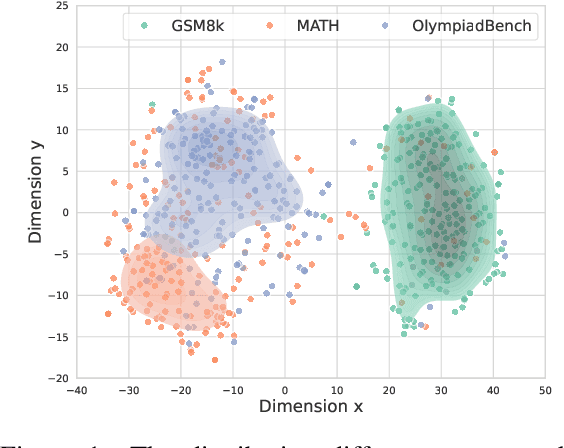
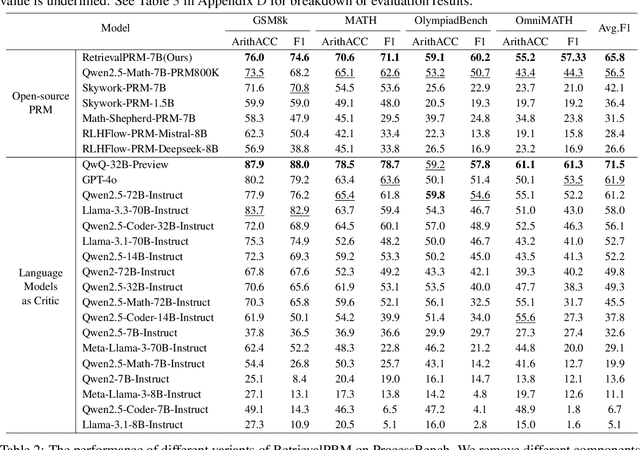
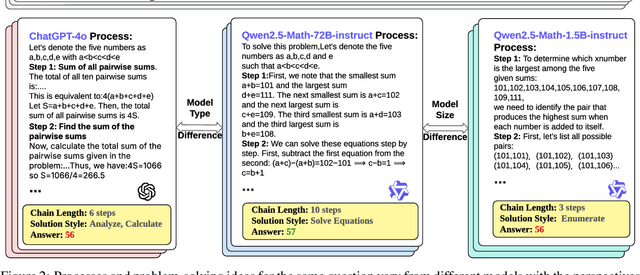

Abstract:While large language models (LLMs) have significantly advanced mathematical reasoning, Process Reward Models (PRMs) have been developed to evaluate the logical validity of reasoning steps. However, PRMs still struggle with out-of-distribution (OOD) challenges. This paper identifies key OOD issues, including step OOD, caused by differences in reasoning patterns across model types and sizes, and question OOD, which arises from dataset shifts between training data and real-world problems. To address these issues, we introduce Retrieval-Augmented Process Reward Model (RetrievalPRM), a novel framework designed to tackle these OOD issues. By utilizing a two-stage retrieval-enhanced mechanism, RetrievalPRM retrieves semantically similar questions and steps as a warmup, enhancing PRM's ability to evaluate target steps and improving generalization and reasoning consistency across different models and problem types. Our extensive experiments demonstrate that RetrievalPRM outperforms existing baselines across multiple real-world datasets. Our open-source contributions include a retrieval-enhanced dataset, a tuning framework for PRM training, and the RetrievalPRM model, establishing a new standard for PRM performance.
MetaMorph: Multimodal Understanding and Generation via Instruction Tuning
Dec 18, 2024Abstract:In this work, we propose Visual-Predictive Instruction Tuning (VPiT) - a simple and effective extension to visual instruction tuning that enables a pretrained LLM to quickly morph into an unified autoregressive model capable of generating both text and visual tokens. VPiT teaches an LLM to predict discrete text tokens and continuous visual tokens from any input sequence of image and text data curated in an instruction-following format. Our empirical investigation reveals several intriguing properties of VPiT: (1) visual generation ability emerges as a natural byproduct of improved visual understanding, and can be unlocked efficiently with a small amount of generation data; (2) while we find understanding and generation to be mutually beneficial, understanding data contributes to both capabilities more effectively than generation data. Building upon these findings, we train our MetaMorph model and achieve competitive performance on both visual understanding and generation. In visual generation, MetaMorph can leverage the world knowledge and reasoning abilities gained from LLM pretraining, and overcome common failure modes exhibited by other generation models. Our results suggest that LLMs may have strong "prior" vision capabilities that can be efficiently adapted to both visual understanding and generation with a relatively simple instruction tuning process.
OpenR: An Open Source Framework for Advanced Reasoning with Large Language Models
Oct 12, 2024



Abstract:In this technical report, we introduce OpenR, an open-source framework designed to integrate key components for enhancing the reasoning capabilities of large language models (LLMs). OpenR unifies data acquisition, reinforcement learning training (both online and offline), and non-autoregressive decoding into a cohesive software platform. Our goal is to establish an open-source platform and community to accelerate the development of LLM reasoning. Inspired by the success of OpenAI's o1 model, which demonstrated improved reasoning abilities through step-by-step reasoning and reinforcement learning, OpenR integrates test-time compute, reinforcement learning, and process supervision to improve reasoning in LLMs. Our work is the first to provide an open-source framework that explores the core techniques of OpenAI's o1 model with reinforcement learning, achieving advanced reasoning capabilities beyond traditional autoregressive methods. We demonstrate the efficacy of OpenR by evaluating it on the MATH dataset, utilising publicly available data and search methods. Our initial experiments confirm substantial gains, with relative improvements in reasoning and performance driven by test-time computation and reinforcement learning through process reward models. The OpenR framework, including code, models, and datasets, is accessible at https://openreasoner.github.io.
A Survey on Diffusion Models for Recommender Systems
Sep 08, 2024Abstract:While traditional recommendation techniques have made significant strides in the past decades, they still suffer from limited generalization performance caused by factors like inadequate collaborative signals, weak latent representations, and noisy data. In response, diffusion models (DMs) have emerged as promising solutions for recommender systems due to their robust generative capabilities, solid theoretical foundations, and improved training stability. To this end, in this paper, we present the first comprehensive survey on diffusion models for recommendation, and draw a bird's-eye view from the perspective of the whole pipeline in real-world recommender systems. We systematically categorize existing research works into three primary domains: (1) diffusion for data engineering & encoding, focusing on data augmentation and representation enhancement; (2) diffusion as recommender models, employing diffusion models to directly estimate user preferences and rank items; and (3) diffusion for content presentation, utilizing diffusion models to generate personalized content such as fashion and advertisement creatives. Our taxonomy highlights the unique strengths of diffusion models in capturing complex data distributions and generating high-quality, diverse samples that closely align with user preferences. We also summarize the core characteristics of the adapting diffusion models for recommendation, and further identify key areas for future exploration, which helps establish a roadmap for researchers and practitioners seeking to advance recommender systems through the innovative application of diffusion models. To further facilitate the research community of recommender systems based on diffusion models, we actively maintain a GitHub repository for papers and other related resources in this rising direction https://github.com/CHIANGEL/Awesome-Diffusion-for-RecSys.
Lifelong Personalized Low-Rank Adaptation of Large Language Models for Recommendation
Aug 07, 2024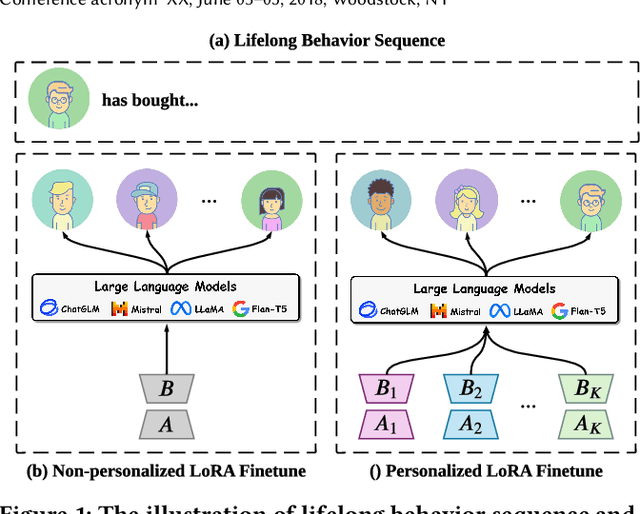

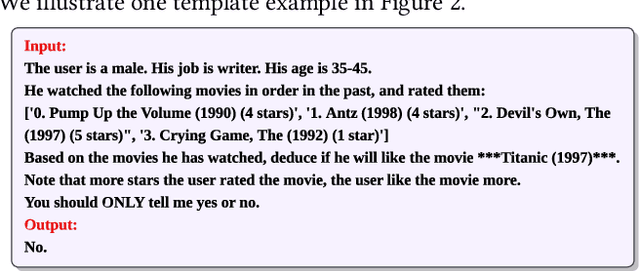
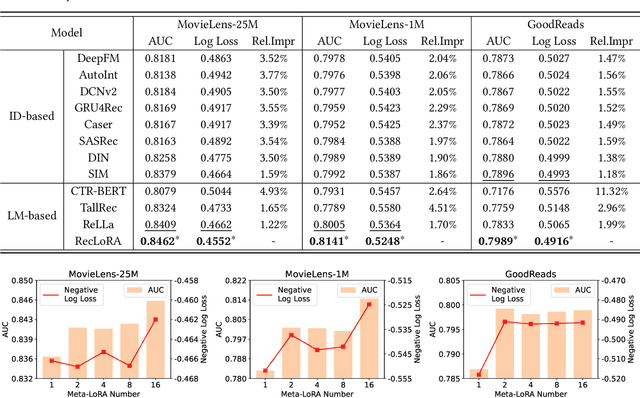
Abstract:We primarily focus on the field of large language models (LLMs) for recommendation, which has been actively explored recently and poses a significant challenge in effectively enhancing recommender systems with logical reasoning abilities and open-world knowledge. Current mainstream efforts mainly center around injecting personalized information from recommendation models into LLMs by customizing input templates or aligning representations between semantic and recommendation spaces at the prediction layer. However, they face three significant limitations: (1) LoRA is mostly used as a core component in existing works, but personalization is not well established in LoRA parameters as the LoRA matrix shared by every user may not cater to different users' characteristics, leading to suboptimal performance. (2) Although lifelong personalized behavior sequences are ideal for personalization, their use raises effectiveness and efficiency issues since LLMs require escalating training and inference time to extend text lengths. (3) Existing approaches aren't scalable for large datasets due to training efficiency constraints. Thus, LLMs only see a small fraction of the datasets (e.g., less than 10%) instead of the whole datasets, limiting their exposure to the full training space. To address these problems, we propose RecLoRA. This model incorporates a Personalized LoRA module that maintains independent LoRAs for different users and a Long-Short Modality Retriever that retrieves different history lengths for different modalities, significantly improving performance while adding minimal time cost. Furthermore, we design a Few2Many Learning Strategy, using a conventional recommendation model as a lens to magnify small training spaces to full spaces. Extensive experiments on public datasets demonstrate the efficacy of our RecLoRA compared to existing baseline models.
M-scan: A Multi-Scenario Causal-driven Adaptive Network for Recommendation
Apr 15, 2024Abstract:We primarily focus on the field of multi-scenario recommendation, which poses a significant challenge in effectively leveraging data from different scenarios to enhance predictions in scenarios with limited data. Current mainstream efforts mainly center around innovative model network architectures, with the aim of enabling the network to implicitly acquire knowledge from diverse scenarios. However, the uncertainty of implicit learning in networks arises from the absence of explicit modeling, leading to not only difficulty in training but also incomplete user representation and suboptimal performance. Furthermore, through causal graph analysis, we have discovered that the scenario itself directly influences click behavior, yet existing approaches directly incorporate data from other scenarios during the training of the current scenario, leading to prediction biases when they directly utilize click behaviors from other scenarios to train models. To address these problems, we propose the Multi-Scenario Causal-driven Adaptive Network M-scan). This model incorporates a Scenario-Aware Co-Attention mechanism that explicitly extracts user interests from other scenarios that align with the current scenario. Additionally, it employs a Scenario Bias Eliminator module utilizing causal counterfactual inference to mitigate biases introduced by data from other scenarios. Extensive experiments on two public datasets demonstrate the efficacy of our M-scan compared to the existing baseline models.
 Add to Chrome
Add to Chrome Add to Firefox
Add to Firefox Add to Edge
Add to Edge